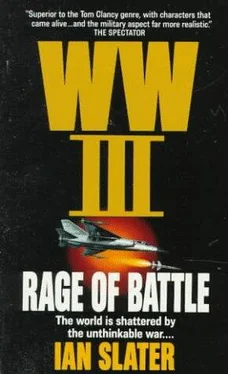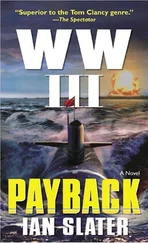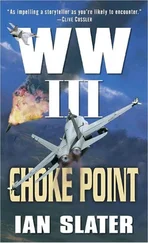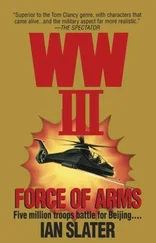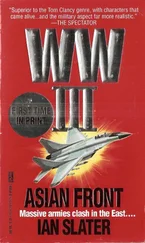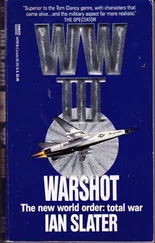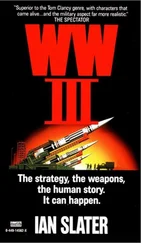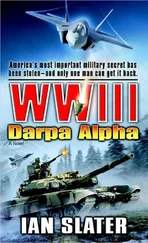Ian Slater - Rage of Battle
Здесь есть возможность читать онлайн «Ian Slater - Rage of Battle» весь текст электронной книги совершенно бесплатно (целиком полную версию без сокращений). В некоторых случаях можно слушать аудио, скачать через торрент в формате fb2 и присутствует краткое содержание. Год выпуска: 1991, ISBN: 1991, Издательство: Ballantine Books, Жанр: Триллер, на английском языке. Описание произведения, (предисловие) а так же отзывы посетителей доступны на портале библиотеки ЛибКат.
- Название:Rage of Battle
- Автор:
- Издательство:Ballantine Books
- Жанр:
- Год:1991
- ISBN:0-345-46514-8
- Рейтинг книги:3 / 5. Голосов: 1
-
Избранное:Добавить в избранное
- Отзывы:
-
Ваша оценка:
- 60
- 1
- 2
- 3
- 4
- 5
Rage of Battle: краткое содержание, описание и аннотация
Предлагаем к чтению аннотацию, описание, краткое содержание или предисловие (зависит от того, что написал сам автор книги «Rage of Battle»). Если вы не нашли необходимую информацию о книге — напишите в комментариях, мы постараемся отыскать её.
Rage of Battle — читать онлайн бесплатно полную книгу (весь текст) целиком
Ниже представлен текст книги, разбитый по страницам. Система сохранения места последней прочитанной страницы, позволяет с удобством читать онлайн бесплатно книгу «Rage of Battle», без необходимости каждый раз заново искать на чём Вы остановились. Поставьте закладку, и сможете в любой момент перейти на страницу, на которой закончили чтение.
Интервал:
Закладка:
“Better strap her down, Rick. Could be a rough ride.”
Everyone wanted to be copilot, but the assignments hadn’t changed — nor had the forecast for a break in the cloud cover around five in the morning.
“Gobble, gobble!” shouted a navigator.
That night Alen slept fitfully, but he didn’t worry. Sometimes when he was bone-weary, against all common sense, he got so hard, it felt like steel. The only thing that worried him was that if she touched him, he mightn’t be able to wait. The closer it got to the 0400 preflight call, the more relaxed and sleepy he became. When he did doze off, he was in a dream — the plane on automatic pilot, the commanding officer of Adak now bawling Alen out for his violation of orders — bringing a Wave on a “goddamned joyride” in the middle of a combat zone. And Alen with no pants on, telling the CO that Lana was merely fulfilling the requirements of her posting — putting in at least thirty hours as required by Waves for the purposes of ATF— air time familiarization — which the pilots called “airtime fucking. “ Alen also pointed out Washington’s rationale — that in the event of the Aleutians being attacked, the Waves would have to help the pilots ferry back the most seriously wounded to either Dutch Harbor or beyond to Anchorage in Alaska, and yet the only flight time most of them had was on the civilian flight from the lower forty-eight states.
At 0407 on the morning of October 17, Alen was feeling so thick from lack of sleep, it took three cups of coffee to pump him awake. The weather report was holding, though in the “caldron of storms,” as the volcanic Aleutians were called, the projected rise in barometric pressure could very quickly disappear. When he got to the fogbound airstrip, the latest weather posting, only an hour old, still called for clearing. But Lana was nowhere in sight.
“Come on,” said the copilot, “let’s go.”
Alen looked plain miserable as the AC-130 E Hercules’ four turboprops sputtered to life, throwing off curls of exhaust into the pea-soup morning. He glanced anxiously at his watch. The most he could delay on preflight recheck was ten minutes. And the weather was getting worse.
“Goddamnit!” said Alen, looking past the copilot at the fog-shrouded runway. “C’mon, c’mon! What the hell’s she doing?”
“Checking her diaphragm!” shouted the copilot.
CHAPTER NINE
Coming in at eight hundred miles an hour on the vector given him when he left Cornwall, the sea a wrinkled bluish slate racing backward beneath him, Roger Fernshaw altered trim, heard the Jaguar’s target-lock-on tone, and fired one of his two Exocets.
The Yumashev’s radar saw the blip of the Jaguar’s Exocet but lost it thereafter in sea clutter echo. Fernshaw, monitoring the head-up display, itself monitoring the side-scan and umbrella radar feed, glanced at the sky above — white cumulus and breaking. A Russian pilot’s radar that, technically speaking, might pick him up wasn’t Fernshaw’s major concern, however, for he was flying so low, trained in the dangerous twisting and turning low-level runs through the glens of Scotland, that he was initially “on the deck,” forty feet above the waves, where the Jaguar’s image would hopefully be lost in the sea clutter blanketing any active radar signals beamed his way.
Firing the second missile fifteen seconds and forty miles after the first, Fernshaw was still safely beyond the Russian cruiser’s best thirty-mile-range Goblet surface-to-air missiles. As he began his turn, doing visual as well as instrument checks, needing height to complete the maneuver, he momentarily took himself out of the clutter. He saw a wink of red against the cobalt-blue sea, most likely the first Goblet leaving the cruiser. For a moment he was struck by the perverse fact that if the twenty-foot-long Russian missile had been upgraded with boosters for a fifty- or even forty-five-mile range, he would be, as his American colleagues in Cornwall were fond of saying, “up Shit Creek without a paddle.” The count for the Exocet missile was now down to thirty-one seconds, and while his radar lit up with Goblet and other AA ordnance opening up at him, the Exocet feed stayed live. At seven seconds Fernshaw saw an orange wink on the horizon blossom, then fade, and on his channel scanner he was picking up excited Russian chatter, presumably radio traffic emanating from the cruiser itself. He didn’t see his second missile hit the cruiser, and scribbled “P/D” on his knee pad, indicating a “probable” or “dud.” He also noted that the seven-second gap between the time the Exocet should have impacted the cruiser and the time it actually did suggested the Jaguar’s ground crew should do a computer overhaul of the fire control system as soon as he returned.
The Exocet hit the Yumashev abaft the starboard beam and below the head-net C radar aerial, the second missile’s explosion gulped by the inferno of the first, though striking farther back in the deck housing below the headlights’ radar, which only minutes earlier had been tracking the incoming Jaguar. The damage to the cruiser’s superstructure would have been much worse had the missiles been better spaced, for much of the second missile’s impact was in an area already hit. Even so, the Exocet’s explosion, on the waterline, well below the head-net aerial, effectively gutted the cruiser, sailors suddenly sucked out from what only moments before had been warm, watertight compartments, their bodies, like so much flotsam, pouring like stunned fish into the ice-cold Atlantic. Only a few of those in the water showed any signs of life as their comrades in the rescue squads threw out the tethered Malvinsky raft-drums, the halves of each container opening in the shape of an ugly mouth into tent rafts whose blossoming was like enormous orange flowers on the heaving surface of the sea.
Forty miles to the northeast, the two Soviet Sukhoi Flagon-Fs accompanying the long-range Badger dispatched by Admiral Brodsky had seen the blue line of the Jaguar’s Exocet as it streaked at deck level toward the sub-chaser Yumashev, but the Sukhois did not leave the Badger. Although capable of a dual role, as a medium bomber and maritime reconnaissance aircraft, the Tupolev-16 Badger, with a maximum speed of 615 miles per hour, was ill suited to go it alone in any seek-and-destroy mission against the reported American Sea Wolf. It badly needed the “in-flight refueled” Sukhois to guard its flanks, and its captain knew that whether or not the two escorting Russian fighters would be called upon to fire their weapons would depend entirely on the pilot of the Jaguar. With the NATO fighter almost certainly approaching the end of its fuel-pod-extended radius of one thousand miles, the Badger’s six-man crew were making wagers as to whether the Allied pilot would engage them in an effort to take out the Badger’s twenty-thousand-pound load of sub-detecting air-launched sonobuoys, MAD-magnetic anomaly detection — gear, and its free-fall ordnance of air-launched depth charges and torpedoes.
For Pilot Officer Fernshaw, however, seeing three Russian aircraft on his radar screen, a decision about whether or not he would attack them was more difficult than they could imagine. The problem was the fighting in Europe. It was going badly for the Western Allies, the half million British, American, and German troops trapped in the Dortmund-Bielefeld pocket surrounded by a steel ring of six hundred T-90s pounding away at them with laser-guided 135-millimeter armor-piercing and high-explosive shells. In the air of sustained crisis in the Allied camp, the decisions being forced upon Whitehall for all British combatants as far down the chain as individual pilots like Fernshaw were often as confused as they were urgent. SACEUR — Supreme Allied Commander in Europe — headquarters, Brussels, was now reporting to England that if all available NATO air cover was not marshaled in defense of the Dortmund-Bielefeld pocket, then NATO’s shriveling central front would cease to be and trip off full-scale collapse all along the German front from the North Sea to Switzerland.
Читать дальшеИнтервал:
Закладка:
Похожие книги на «Rage of Battle»
Представляем Вашему вниманию похожие книги на «Rage of Battle» списком для выбора. Мы отобрали схожую по названию и смыслу литературу в надежде предоставить читателям больше вариантов отыскать новые, интересные, ещё непрочитанные произведения.
Обсуждение, отзывы о книге «Rage of Battle» и просто собственные мнения читателей. Оставьте ваши комментарии, напишите, что Вы думаете о произведении, его смысле или главных героях. Укажите что конкретно понравилось, а что нет, и почему Вы так считаете.
